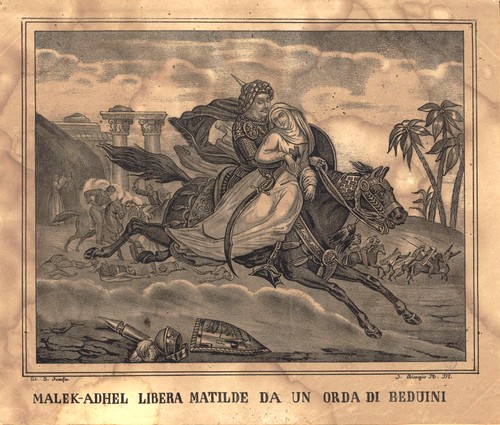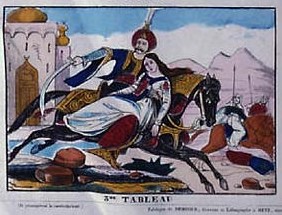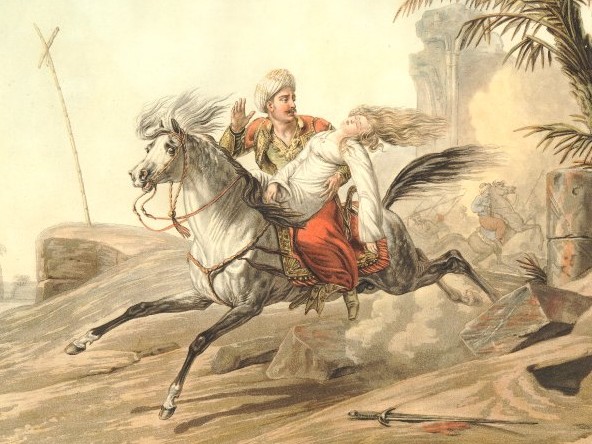We intended to
beg your
assistance to answer these questions… And the main one :
what is represented in this scene? As we thought
we had already seen such a fan, or at least such an engraving (but
where ???), we were fancying it was a
contemporary testimony of the famous Delacroix painting “the
Massacres of Scio”.

Lord Byron, par Odevaere ©[louvre.edu] - photo Erich Lessing |
We already evoked Byron dying in Missolonghi , or Victor Victor
Hugo in his Orientales poetry book…
“Ô horror! horror!
horror! ”, W. Shakespeare, Macbeth
The Turks have passed there. All is ruin
and mourning.
Chio, the
island of the wines, is nothing any more but one dark shelf,
Chio, which the hedges shadowed
Chio which in the
floods reflected its large woods,
Its slopes, its
palaces, and sometimes
in the evening
A dancing
chorus of girls.
|
… But
we were totally mistaken!… In fact we are seeing Malek-Adhel raping Mathilde.
This was a fashionable subject (in particular for the “grocers
clocks” will say some grumbling critics) after
“Mathilde”, a novel by Mrs. Sophie Cottin published in 1805
and often republished and translated thereafter. (Mathilde ou Mémoires tirés de l’histoire des croisades, Paris, Giguet et Michaud, 1805, 6 vol., in-12).
The scene of our fan is fairly well described there : the heroin,
a Christian princess in Palestine at the time of the 3rd crusade is
about to be victim of an attack of Bedouins. A warrior emerges who
furiously tackles the Bedouins and kills them. He seizes the girl and
bring her outside In the ruins, the Christians succumbed under
the number; and the surviving brigands, “out of mind from
terror”, flee, howling the name of their attacker:
“Malek-Adhel”:
“[...he sees only
Mathilde, he thinks only of its dangers ; he poses her on a superb
horse and rides behind her.
With
a hand he presses her against him, with the other he seizes the
horse support, and followed by a few Moslem soldiers, moves away
at full gallop from this scene of carnage.”
  [678181] mage
d'Epinal DEMBOUR Adrien (graveur, imprimeur, libraire, éditeur)
[678181] mage
d'Epinal DEMBOUR Adrien (graveur, imprimeur, libraire, éditeur)
Paris
musée national des Arts et Traditions Populaires
© iconothèque MNATP
Through the British Museum website we discovered (quite late) the
certain source of the image on our fan. It is an 1815-1820 engraving by
Charles François Gabriel Levachez (Fl. 1780-1820), printed by Roland
and according to the museum notice, after a painting by Horace Vernet
(1789-1863). This print is known, and is part of a series. Another
drawing of the series, "Malek Adhel saves Mathilde from the Bedouin
Arabs fury", went on sale November 22, 2002 (Mes Calmels Cohen, Paris).
Other prints of this scene are identified. And the Bibliographie de France notes :
June 11, 1842, no. 892 Smuggler
scenes: designs for fans. - (...) - Some Chinese scenes, drawings for
fans. - Death of Malek
Adhel:
Malek-Adhel expiring in the arms of Matilda. - Malek-Adhel raping
Mathilde: this faithless man taking on his galloping horse the
young Christian in a religious costume. - Malek-Adhel seizes Mathilde
and Berengaria: Malek-Adhel taking them into a boat. In Paris, at {}.
Other prints will be available later, reflecting the success of this
story, which probably accompanied the French expansion in North Africa.
All prints mentioned above are not clearly for fans... Some
indications lead us to believe that Boulard, a prolific editor of fan
leaves, contributed to the making of our fan, and maybe Nargeot,
who engraved a lot of etched and stipple-engraved fan leaves.
Sophie Cottin was a recognized and popular novelist, appreciated by the
elite (even Madame de Stael incensed her, and also Madame de Genlis,
with a hint of jealousy), but also by very ordinary people. In his
Ph.D. thesis Sophie Cottin, une
romancière oubliée à l'orée du Romantisme -Une vie, une oeuvre, contribution à l'étude
de la réception*, David Paul Bianciardi wrote:
Testimonies exist
of persons entering modest house where on the walls are pinned two
engravings: Atala dying in the arms of Choctaw and Malek-Adhel expiring
in the arms of Matilda. In other words, Ms. Cottin was the equal of the
great Chateaubriand and both works, Atala and Matilda, were undoubtedly
the two highest achievements of French literature of the imperial
period.
This story, in some
way, is reminiscent of that of Angelica and Medoro that we evoke
in another page.
But this is another story. Meanwhile, dear visitors,
amateurs of fans or simple idlers, if you want to
give an opinion (or, better still, photographs of other fans
illustrating this same novel, or others of the same author!) thank you
for sharing. Please go to the Home Page and email.
*
soutenue le 27
octobre 1995 à la Faculté des Lettres et des Sciences Humaines de Metz
-mention très honorable avec félicitations du jury (MM. Jacques
Hennequin / Roger Marchal / Eric Fauquet, rapport de M. Jean Gaulmier).
|
r |
u





